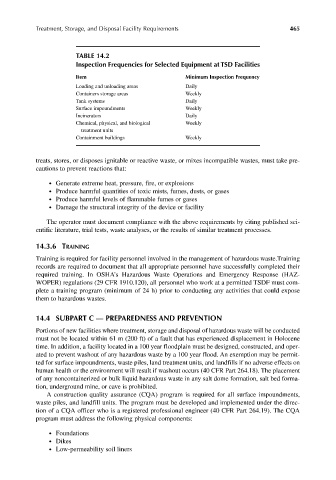Page 494 - Materials Chemistry, Second Edition
P. 494
CAT3525_C14.qxd 1/27/2005 12:37 PM Page 465
Treatment, Storage, and Disposal Facility Requirements 465
TABLE 14.2
Inspection Frequencies for Selected Equipment at TSD Facilities
Item Minimum Inspection Frequency
Loading and unloading areas Daily
Containers storage areas Weekly
Tank systems Daily
Surface impoundments Weekly
Incinerators Daily
Chemical, physical, and biological Weekly
treatment units
Containment buildings Weekly
treats, stores, or disposes ignitable or reactive waste, or mixes incompatible wastes, must take pre-
cautions to prevent reactions that:
● Generate extreme heat, pressure, fire, or explosions
● Produce harmful quantities of toxic mists, fumes, dusts, or gases
● Produce harmful levels of flammable fumes or gases
● Damage the structural integrity of the device or facility
The operator must document compliance with the above requirements by citing published sci-
entific literature, trial tests, waste analyses, or the results of similar treatment processes.
14.3.6 TRAINING
Training is required for facility personnel involved in the management of hazardous waste.Training
records are required to document that all appropriate personnel have successfully completed their
required training. In OSHA’s Hazardous Waste Operations and Emergency Response (HAZ-
WOPER) regulations (29 CFR 1910.120), all personnel who work at a permitted TSDF must com-
plete a training program (minimum of 24 h) prior to conducting any activities that could expose
them to hazardous wastes.
14.4 SUBPART C — PREPAREDNESS AND PREVENTION
Portions of new facilities where treatment, storage and disposal of hazardous waste will be conducted
must not be located within 61 m (200 ft) of a fault that has experienced displacement in Holocene
time. In addition, a facility located in a 100 year floodplain must be designed, constructed, and oper-
ated to prevent washout of any hazardous waste by a 100 year flood. An exemption may be permit-
ted for surface impoundments, waste piles, land treatment units, and landfills if no adverse effects on
human health or the environment will result if washout occurs (40 CFR Part 264.18). The placement
of any noncontainerized or bulk liquid hazardous waste in any salt dome formation, salt bed forma-
tion, underground mine, or cave is prohibited.
A construction quality assurance (CQA) program is required for all surface impoundments,
waste piles, and landfill units. The program must be developed and implemented under the direc-
tion of a CQA officer who is a registered professional engineer (40 CFR Part 264.19). The CQA
program must address the following physical components:
● Foundations
● Dikes
● Low-permeability soil liners

